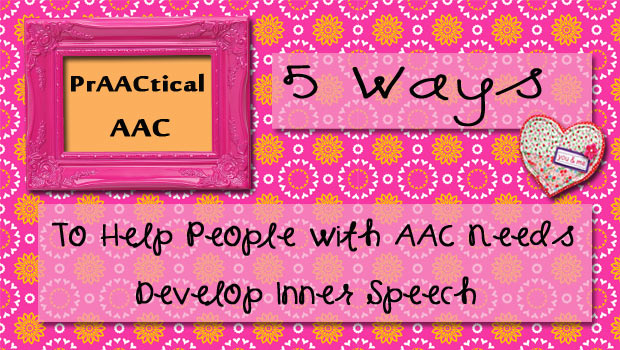5 Ways to Help People With AAC Needs Develop Inner Speech

Recent research has strengthened this clinician’s belief that developing inner speech is an important strategy for many people who use AAC and are working to build their literacy skills. But how do we teach someone to develop that inner voice? Here are some ideas.
–
1. Begin by using a ‘think aloud’ strategy to make your internal thought processes obvious to the person who uses AAC. Articulating your thoughts as you work through different communication and literacy learning processes gives the learner insight into what you are thinking. Once they are used to that, it is easier to introduce the concept of private/inner speech.
–
2. Use explicit instruction. “Say it to yourself.” “Say it in your head.” Using natural gestures, like tapping your temple, can be helpful as well. We’ve found that this allows us to reduce the prompting over time. Fade the verbal prompt and continue the gestural one, until that is no longer needed. (Some of our friends who use AAC even self-cue to use their inner speech with that gesture.)
.
3. Consider online books where the text is spoken aloud for some of the person’s reading experiences. This isn’t something we’d want to do all of the time, but some of it may help build that inner voice.
–
4. Talking word processing programs, like Write Outloud, can also support this effort.
–
5. Try setting the SGD to speak each word aloud as the AAC user inputs it, rather than just speaking the whole message when it is complete. We’ve worked with many older children and adults who are now competent communicators and can tell us about the role that their inner speech played in developing their language and reading skills. A few of them have asked for this setting in their SGDs for just that reason.
—
Filed under: PrAACtical Thinking
This post was written by Carole Zangari

4 Comments
Thanks for this list. I had not realized that the last idea could help with developing inner voice.
Thanks for your comment, Jeanne. I think that, for some of our folks, it works somewhat like subvocalizing does for other kids. In most situations the focus is really on the communication and interaction (as it should be) but having the word-by-word voice output does give a measure of focus that seems to be important to some of the folks we’ve worked with.
Thanks Carole! I talk to people about this a lot – and nice to have a blog to refer them to. Another thing I do is talk to the person about explicitly picking a “voice” to use as their inner voice – I think this was a Karen Erickson idea and it works well for many students. Some pick mum or their teacher or their twin – but it seems to help them to implement their inner voice
.
Such a great suggestion, Jane. I know many of the people I’ve talked to about this ‘hear’ the voice of a good teacher or SLP but I don’t know that they ever made a conscious decision about this. It’s always fun to have those metacognitive conversations. I think Kathleen Turner would be my pick for an inner voice. Can’t you see the similarities?